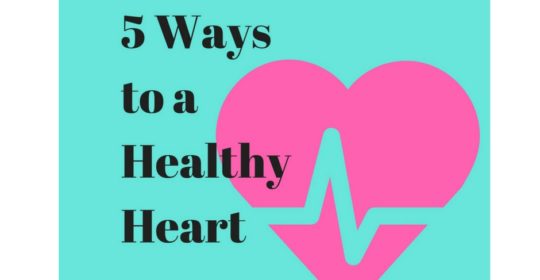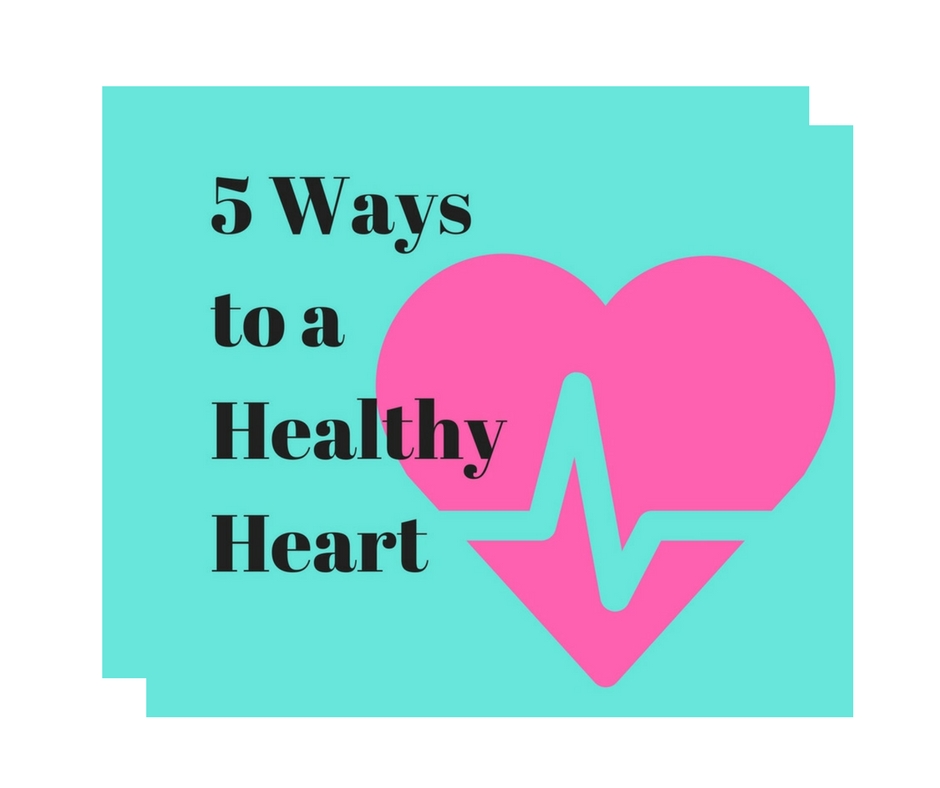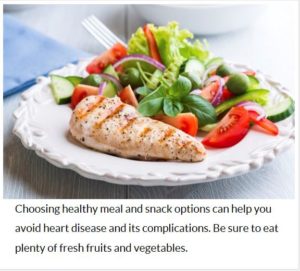
5 Ways to a Healthy Heart

Heart disease is the leading cause of death in the United States. According to Center for Disease Control and Prevention (CDC), more than 600,000 Americans die of heart disease each year, equivalent to one in every four deaths in this country.
What is heart disease?

Heart and blood vessel disease — also called heart disease — includes numerous problems, many of which are related to a process called atherosclerosis. Atherosclerosis is a condition that develops when a substance called plaque builds up in the walls of the arteries. This buildup narrows the arteries, making it harder for blood to flow through. If a blood clot forms, it can stop the blood flow and could cause a heart attack or stroke.
Anyone, including children, can develop heart disease. Smoking, eating an unhealthy diet, and not getting enough exercise all increase your risk of having heart disease. Having high cholesterol, high blood pressure or diabetes also can increase your risk for heart disease. Several other medical conditions and lifestyle choices can also put people at a higher risk for heart disease, including obesity and excessive alcohol use.
What are the signs and symptoms?
The symptoms vary depending on the type of heart disease. For many people, chest discomfort or a heart attack is the first sign. Someone having a heart attack may experience several symptoms, including:
- Chest pain or discomfort that doesn’t go away after a few minutes.
- Pain or discomfort in the jaw, neck, or back.
- Weakness, light-headedness, nausea (feeling sick to your stomach), or a cold sweat.
- Pain or discomfort in the arms or shoulder.
- Shortness of breath.
Can it be prevented?
Lack of exercise, a poor diet, and other unhealthy habits can take their toll over the years. Anyone at any age can benefit from simple steps to keep their heart healthy during each decade of life. Heart disease can be prevented with the following healthy living habits:
1. Healthy Diet
When it comes to your heart, what you eat matters. The food you eat can decrease your risk of heart disease and stroke. By choosing healthy meals and snack options, you can help avoid heart disease and its complications.
Eat less saturated and trans fat.
Our body needs us to consume fat in order to work properly. Fat is a major source of energy and helps your body absorb vitamins. It is also important for proper growth, and for keeping you healthy. A completely fat-free diet would not be healthy, yet it is important that fat is consumed in moderation. It is important to keep in mind that fat has the most calories compared to any other nutrient. Controlling fat intake is one of the most important steps in losing or maintaining weight and preventing or delaying type 2 diabetes.
Saturated Fats are mainly found in foods that come from animals (such as meat and dairy), but they can also be found in most fried foods and some prepackaged foods. Saturated fats are unhealthy because they increase LDL (“bad” cholesterol) levels in your body and increase your risk for heart disease. Many saturated fats are “solid” fats that you can see, such as the fat in meat.
Trans fat is simply liquid oils turned into solid fats during food processing. There is also a small amount of trans fat that occurs naturally in some meat and dairy products, but those found in processed foods tend to be the most harmful to your health.
- Stay away from processed food. While not all processed foods are unhealthy, some processed foods may contain high levels of salt, sugar, and fat that were added to make their flavor more appealing and to extend their shelf life.
- Choose margarine and spreads that have no trans fats, light mayonnaise or salad dressing that are oil based instead of creamy.
- Choose lean cuts of meat and other foods with protein, such as chicken and turkey breast without skin, extra lean ground beef, unsalted nuts and seeds, seafood, including fish and shellfish.
- Look for fat-free or low-fat dairy products, such as fat-free or low-fat (1%) milk, soy milk with added calcium, fat-free or low-fat yogurt (with less added sugar), cheese products that have 3 grams of fat or less per serving.
- In order to avoid trans fat, look on nutrition labels for ingredients such as “partially hydrogenated” oils or shortening. In addition, look for trans fat in the nutritional information in products, such as commercially baked cookies, crackers, and pies, and fried foods.
Get more fiber.

A high-fiber diet can also reduce the risk of stroke, hypertension, and heart disease. Fiber comes in two varieties, soluble and insoluble. Most plant-based foods contain a mixture of the two. Soluble fiber turns to gel in the stomach and slows digestion, which helps lower cholesterol and blood glucose. Insoluble fiber, on the other hand, remains unchanged all the way to the colon, making waste heavier and softer so it can pass through the intestines more easily.
Eat more vegetables and fruits. They are good sources of vitamins and minerals, low in calories, and rich in dietary fiber. Eat a variety of vegetables and fruits. Buy vegetables and fruits that are in season, frozen, dried (unsweetened), or canned. When choosing canned fruit, select fruit in 100% juice, not syrup. Incorporate whole grains to add fiber to your diet. For example, when shopping for carbohydrate products, choose products with whole grains listed as their main ingredients, such as whole wheat bread, whole wheat cereal, and pasta.
Cut down on salt (sodium)
Most of the sodium we consume is in the form of a salt, and the vast majority of sodium we consume is in processed and restaurant foods. Your body needs a small amount of sodium to work properly, but too much sodium is bad for your health. Excess sodium can increase your blood pressure and your risk for heart disease and stroke. That’s why the American Heart Association recommends limiting the amount of sodium you eat to less than 1,500 mg per day for ideal heart health. That’s about two-thirds of a teaspoon of salt.
- Cut down on processed foods since many processed foods have salt added either for preservation, safety, or simply to increase the flavor.
- Look for the low-sodium or “no salt added” types of canned soups, vegetables, snack foods, and lunch meats.
2. Maintaining Healthy Weight
Reaching and maintaining a healthy weight is important for overall health and can help you prevent and control many diseases and conditions. If you are overweight or obese, you are at higher risk of developing serious health problems, including heart disease, high blood pressure, type 2 diabetes, gallstones, breathing problems, and certain cancers.
To determine if your weight is in a healthy range, doctors often calculate your body mass index (BMI). If you know your weight and height, you can calculate your BMI at CDC’s Assessing Your Weight website. Doctors sometimes also use waist and hip measurements to calculate excess body fat. They may use special equipment to calculate excess body fat and hydration status.
3. Regular Exercise
To effectively improve your heart health is to start regular exercise. Regular exercise helps in reducing the risk of chronic diseases, such as diabetes, high blood pressure, and heart disease. It also can help you maintain a healthy weight.
- Start with walking, it is the simplest exercise that will help you stick with a regular exercise plan. Walking is enjoyable, free, easy, social, and great exercise. Start with 10 – 15 minutes a day then gradually increase your time as you work toward your overall goal of 30 minutes a day.
- For overall cardiovascular health, the American Heart Association recommends doing either/or at least 30 minutes of moderate-intensity aerobic activity at least 5 days per week for a total of 150 minutes, at least 25 minutes of vigorous aerobic activity at least 3 days per week for a total of 75 minutes; or a combination of moderate- and vigorous-intensity aerobic activity and Moderate- to high-intensity muscle-strengthening activity at least 2 days per week for additional health benefits.
- For lowering blood pressure and cholesterol an average of 40 minutes of moderate- to vigorous-intensity aerobic activity 3 or 4 times per week.
4. Not Smoking

Cigarette smoking greatly increases your risk for heart disease. If you don’t smoke, don’t start. If you do smoke, quitting will lower your risk for heart disease. Chemicals in cigarette smoke cause the cells that line blood vessels to become swollen and inflamed. This can narrow the blood vessels and can lead to many cardiovascular conditions.
Even people who smoke fewer than five cigarettes a day may show signs of early cardiovascular disease. The risk will increase with the number of cigarettes smoked per day, and when smoking continues for many years.
Smoking cigarettes with lower levels of tar or nicotine do not reduce the risk for cardiovascular disease. Exposure to secondhand smoke causes heart disease in nonsmokers
5. Limiting Alcohol Consumption
Drinking too much alcohol can raise the levels of some fats in the blood (triglycerides). It can also lead to high blood pressure, heart failure, and an increased calorie intake which can lead to obesity and a higher risk of developing diabetes. Excessive drinking and binge drinking can lead to stroke and other serious problems including fetal alcohol syndrome, cardiomyopathy, cardiac arrhythmia, and sudden cardiac death.
Excessive alcohol use has short-term and long-term health risks. Short-term health risks include injuries from accidents such as motor vehicle crashes, violence, alcohol poisoning, risky sexual behaviors, miscarriages, and stillbirths.
over time, excessive alcohol use can lead to the development of chronic diseases and other serious problems including:
- High blood pressure, heart disease, stroke, liver disease, and digestive problems.
- Cancers of the breast, mouth, throat, esophagus, liver, and colon.
- Learning and memory problems, including dementia and poor school performance.
- Mental health problems, including depression and anxiety.
- Social problems, including lost productivity, family problems, and unemployment.
- Alcohol dependence, or alcoholism.
By not drinking too much, you can reduce the risks of these short- and long-term health issues.
Evaluation and treatment for High Cholesterol and Hypertension are available now at South Atlanta Urgent Care Clinic in Atlanta.
Source:
- CDC
- AHA
- NHLBI
Pictures Credit:
- CDC


Most Commented